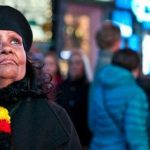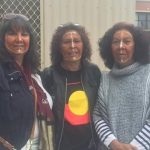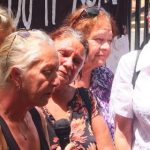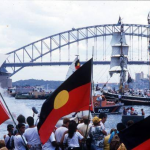The Rise of Redfern’s Black Power Movement: An Interview with Professor Gary Foley
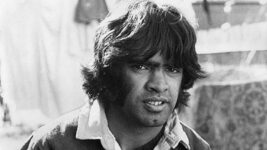
On January 25 1972, then Australian prime minister Billy McMahon stated that his government refused to grant Aboriginal land rights. The conservative politician made the announcement in response to the growing lands rights movement of the time.
The fact that McMahon made his statement on the day prior to one that marks the dispossession of Aboriginal and Torres Strait Islander peoples from their lands was lost upon no one.
Local Aboriginal activists from the inner city Sydney suburb of Redfern were not impressed. They decided to confront the federal government. Four young men drove down to Canberra and on January 27, pitched a tent on the lawns of Parliament House, proclaiming it the Aboriginal Embassy.
Taking back the power
In his 2001 article Black Power in Redfern 1968 – 1972, Professor Gary Foley described the Aboriginal Tent Embassy as the Black Power movement’s “greatest coup.” While former PM Gough Whitlam acknowledged its role in helping topple 22 years of conservative rule in this country.
The Black Power movement comprised of young politically mobilised First Nations people centred in Redfern, who were rising against the oppressive Australian system. As Dr Foley puts it in his history of the movement, the time was “the most exciting and dynamic era in modern Indigenous history.”
In the late 1960s, the Redfern activists began monitoring NSW police officers operating in the local area and keeping a record of police harassment. And this led the group to come under the scrutiny of the NSW Crime Surveillance Unit, as well as ASIO.
The professor, who was a prominent member of the movement, also notes the significance of the establishment of the Redfern Aboriginal Legal Service in 1970, which the group was instrumental in bringing about.
The Springbok tour
In June 1971, the South African Springbok rugby union team arrived in Australia for a six week tour. The Black Power movement carried out a series of actions against the presence of the apartheid regime footballers.
One of these demonstrations saw Professor Foley, along with other members of the movement, turning up outside the footballer’s hotel wearing Springbok jerseys. This outraged the South Africans and made the front page of the papers.
As Gumbainggir man Dr Foley recalls, the actions and events carried out around the tour significantly drew the attention of middle Australia to its own racism. And then there was the irony of setting up an embassy on land that had never been ceded.
The greatest coup
The numbers of people gathered at the Aboriginal Tent Embassy swelled. Its call for land rights and recognition of Aboriginal sovereignty irked the McMahon government. And it also drew the support of soon-to-be prime minister Gough Whitlam.
Politicians attempts to legislate the removal of the embassy, along with a number of large standoffs with police, further discredited the government and popularised the Aboriginal movement. And in December 1972, McMahon was voted out of office.
Sydney Criminal Lawyers® spoke to Victoria University History Professor Gary Foley about the backdrop to the rise of the movement, the contributions it made, and his take on the state of Indigenous affairs at present.
Professor Foley, the Black Power movement rose up in late 1960s/early 1970s Redfern, as well as in other areas around the country like Melbourne’s Fitzroy and South Brisbane.
What was it about that moment in time that led to such a prominent movement coming to the fore?
It was in the context of a broader international movement that was happening generally in the late 60s/early 70s. There was a multitude of planets aligning.
There was the so-called international youth rebellion. There was Paris 1968. The anti-war movement in America and Australia. The Black Panther movement that arose to counter the wishy-washy nonsense of the NAACP and Martin Luther King in America. And there was the American Indian movement, which was the radical wing of the Native American movement of the time.
In Sydney in the late 60s, we had premier Robert Askin. He was probably the most notoriously corrupt NSW premier, which is really saying something, given the long history of corruption in NSW, going all the way back to the Rum Rebellion.
So, you had a very corrupt government in power in Sydney at the time. You had a corrupt police force, who, for reasons known only to themselves, chose to send in the 21 Division, who again were notoriously corrupt.
The 21 Division were the thugs that might be described as the early version of the paramilitary police in NSW. They had been set up in the 1930s to counter the razor gangs in Darlinghurst. They were then sent into the Aboriginal community allegedly to placate us.
It also coincided with a period that effectively ended the NSW apartheid system: the old Aborigines Protection Board, later the Welfare Board. That was unravelling by about 1966-67.
That led to the huge mass exodus of Aboriginal people from the rural areas in NSW that took the Aboriginal population of Sydney from 1,600 in about 1966 to 35,000 by 1969.
So, all of those things were factors that went into the pot from which boiled the Black Power movement.
What would you say were the main objectives of those involved in the movement?
In line with what was going on internationally, the Black Power movement in Australia was an anti-imperialist, anti-colonial movement. We were opposed to colonialism. And we were opposed to imperialism.
That’s why the Black Power movement was invariably and logically linked to international struggles, such as the movement by the Vietnamese people to overcome the French colonisers, who were then followed by the Americans and Australians, who also interfered in their country.
It was why we felt an affinity with what had gone on in Cuba. It was why we felt an affinity with the 1949 revolution in China. It was all part of a bigger picture.
You mentioned the NSW police. In 1969, members of the Black Power movement began monitoring Redfern police. What initiated that program? And what did it involve?
What initiated it was the police harassment campaign that was being bunged on by the corrupt NSW police. In particular, the 21 Division and corrupt coppers who were trying to set up a heroin racket amongst the growing Aboriginal population in Redfern.
They attempted to intimidate and brutalise the community, and in response to that, a small group of us chose to resist.
And in resisting we looked at other contexts in other parts of the world, where we thought similar things had been going on and we adopted and adapted various strategies and tactics, which led into setting up what was loosely called “the Pig Patrol in Redfern.”
In 1970, the Aboriginal Legal Service was set up on Regent Street in Redfern. What sort of impact did the service have for Indigenous people at the time? And what would you say it’s legacy has been?
In the first instance, the Redfern Aboriginal Legal Service was effectively the introduction into the Australian social and political context of the notion of free shop-front legal aid. We introduced the idea of free legal aid into the Australian political scene.
So, that’s one significant thing about the opening of the doors of the Redfern Aboriginal Legal Service.
We were the forerunner of what later became a universal notion under the Whitlam government. It was literally destroyed 10 years later under the Hawke government.
The idea of free legal aid, which most people who were born after 1988 know nothing about, existed in Australia from the late 60s through to the early 80s. It was an idea that we produced.
The impact in Redfern was immediate. Instead of coppers being able to arbitrarily arrest people and sling dozens of Aboriginal people into gaol on trumped up charges, the coppers suddenly found that Aboriginal people had to the capacity for the first time ever to defend themselves.
Once Aboriginal people started being defended in courts, it became more difficult for the police to operate with the impunity that they’d enjoyed prior to that.
There was a brief period in time when the Aboriginal Legal Service was incredibly effective in NSW.
The events that transpired during the 1971 Springbok rugby union tour had a profound effect on the Indigenous political movement.
Why were the protest actions that were undertaken by the Redfern activists, like yourself, so significant?
They were significant because prior to the rugby tour happening there was an upsurge in anti-racist demonstrations by the anti-apartheid movement in Australia. This consisted at the time of primarily a bunch of white, middle class students.
And at one of their rallies, Paul Coe jumped up and challenged the participants of that movement. He said, “Isn’t it hypocritical of you people demonstrating against racism halfway around the globe, when perhaps you should be looking at the situation in your own backyard and accepting the proposition that in Australia you are part of the problem, rather than part of the solution that you see yourselves as internationally.”
The challenge that Coe threw at them was taken up. And as a result, the major Aboriginal land rights demonstrations that had been occurring through 1970, as part of the Black Power movement’s broader national strategy, suddenly they increased in numbers dramatically.
All of that made the government in Canberra, under prime minister Billy McMahon, increasingly nervous throughout 1971.
And that culminated in McMahon making his famous mistake politically, when he decided that the demonstrations had become so large in support of Aboriginal land rights by the end of 1971 that he felt compelled to make his famous statement on Aboriginal land rights on the eve of Invasion Day 1972.
That instantly triggered the Aboriginal Embassy and the rest is history.
You mentioned the embassy. Why was it so successful?
It’s the most significant and successful Aboriginal political action of the entire 20th century.
And looking back what would you say are the legacies of the Black Power movement today? Where can you see its influence being felt?
In Melbourne, on 26 January this year, 60,000 people marched on the streets. That’s the legacy of the Black Power movement. It never died.
The organisers of the 60,000 people marching along the streets in Melbourne are the grandchildren of the Black Power movement. Literally, they are the grandchildren.
At present Indigenous incarceration rates in this country are proportionally the worst in the world.
Absolutely.
Aboriginal deaths in custody continue to occur, and the number of First Nations children being forcibly removed from their families is increasing.
How would you compare the state of affairs for Aboriginal and Torres Strait Islander peoples today, with that of the early 1970s?
It’s a thousand times worse. But, you had a $50 million Royal Commission 30 years ago that clearly spelt out the reason as to why that was happening then and continues to happen today.
The Royal Commission said that the reason that was happening was because of the deeply embedded racism within the Australian criminal justice system. It’s that straightforward.
And lastly, Professor Foley, you’ve been at the forefront of the Indigenous rights movement in this country for close to half a century. What do you think needs to happen now? What sort of developments do you advocate take place?
I don’t advocate anything. I’m an educator. I’m a professor of history. I was an activist for 30 years or so. I’m no longer that. I’m a pessimist.
I believe that the only hope for black Australians, probably for Australia itself, is within this younger generation who’ve emerged recently. The generation both in the Aboriginal community, and the broader Australian community, who followed my generation politically were a waste of space.
The younger generation today are the only real hope for the future of both black and white Australia.
If they don’t succeed in shaking the foundations sufficiently to bring about significant change then, among other things that will happen in 50 years time, there will be no Aboriginal people. The assimilation project will be complete. The genocide will be over.


